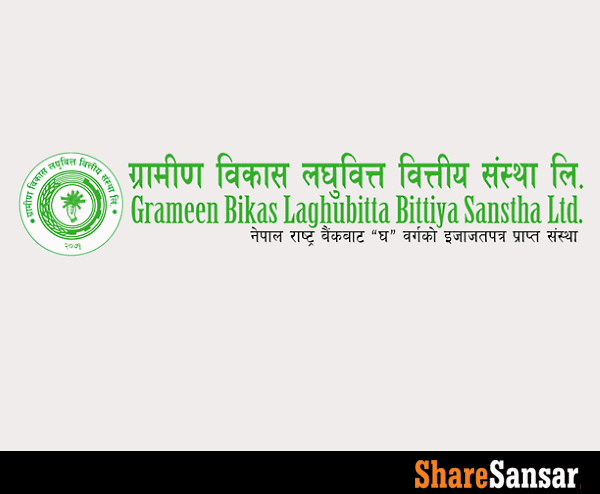50% right share of Grameen Bikas Laghubitta Bittiya Sanstha opens from tomorrow; Things to know before investing
Thu, May 9, 2019 2:20 PM on Dividend, Bonus & Rights, Exclusive, Stock Market, Latest,

Company profile
Grameen Bikas Laghubitta Bittiya Sanstha (GBLBS) was incorporated in 2014 after the merger of erstwhile five regional Grameen Bikas banks [Purwanchal (Eastern), Madhyamanchal (Central), Paschimanchal (Western), MadhyaPaschimanchal (Mid-Western) and Sudur-Paschimanchal (Far western)] . These regional Grameen Bikas banks (established between 1993 and 1997) were promoted by the Nepal Government and Nepal Rastra Bank (NRB, the banking sector regulator) in collaboration with NRB licensed BFIs to replicate the Grameen model and increase financial access among the poorer sections of the community. Over the years of operation, most of these Grameen Bikas Banks faltered under rising NPLs and operational inefficiencies leading to large accumulated losses. As a measure to revive these ailing institutions, GoN and NRB initiated the process of merger among five regional Grameen Bikas Banks which was eventually concluded in August 2014.
As on mid-October 2018, GBLBS has presence across 57 districts of Nepal through its 188 branches, five regional offices and one head office. According to the unaudited report published by GBLBS, its net profit as of third quarter of FY 2075/76 stands at Rs 16.44 crore, with paid-up capital of Rs 65.5 crore and a reserve and surplus balance of Rs 56.02 crore.
Objective of the issue
The primary objectives of the issue are to meet the minimum capital requirement as mandated by NRB, to expand the branch network and to strengthen the capital foundation. The company aims to mobilize the collected money in the following manner:

About the issue

Capital structure

Shareholding composition

Promoter shareholders

Board of directors

Management team
CEO - Parbat Kumar karki
ICRA rating
ICRA Nepal has assigned an “[ICRANP] IPO Grade 4,” indicating below average fundamentals to the proposed rights issue of Grameen Bikas Laghubitta Bittiya Sanstha Limited (GBLBS. GBLBS plans to come out with the 50% rights issue of 3,275,000 equity shares with a face value NPR 100 each, at par for its existing shareholders. The issue is being made in order to maintain the regulatory minimum capital adequacy ratio for microfinance institutions (MFIs).
Strengths and opportunities
- Strong promoter profile (~30% holding by Government of Nepal (GoN), ~3% holding by Nepal Rastra Bank (NRB) and ~14% holding by NRB licensed Class A commercial banks).
- Large scale of operation encompassing wide geography (188 branches across 57 districts of Nepal as on mid-Oct-2018) and customer base, which is expected to support incremental credit growth.
- Growth opportunities for GBLBS remain adequate, given its adequate presence across the country, future expansion plans and large below-poverty-line population in Nepal, the target group for MFIs.
- Recent regulatory change removing the 18% cap on lending rate for the MFIs, enabling them to pass on the increased cost of funds to ultimate borrowers.
Weaknesses and threats
- Relatively weak asset quality indicators (nonperforming loans-NPLs of 4.82% as of mid-October 2018).
- Weak capitalization profile (capital to risk assets ratio- CRAR of 7.41% as of mid-Oct-2018 in breach of regulatory minimum of 8%) remains a concern, although it is likely to be mitigated after the proposed rights issue (assuming full subscription).
- Weak management information system (MIS) which limits the extent of management oversight and control.
- Frequent changes in the regulations affecting spreads and funding sources for the MFI sector. Despite the removal of the 18% cap on lending rates, MFI’s lending spread has been capped at 6% (earlier 7%) and the maximum allowable operating cost has been capped at 3% (4% earlier) which can affect GBLBS’ profitability.
- Increased ticket size following the regulations.
- Presence of a large number of players in the industry (including cooperatives).
- Absence of centralized credit information for MFI
Financial performance

Source: Company prospectus and ICRA Rating


